Seek Thermal Pro vs Seek Thermal. Is it worth it?
In a follow-up to the usual Seek Thermal, the Dadjet sent me a Pro version of it, so that I could write down a comparative review. What now and do:
▌ Packing
It is surprisingly different. And I liked the box from the regular version more. Although the strength and rigidity of both are beyond doubt. For shipment you can not be afraid. Armor, not box. True, it would be better for manufacturers not to show off and put it still in the case before the heap, and not lay it out on the lodgements.

')
The case is the same, but there is a small protrusion under the larger lens of the Pro version. And so the same thing - good-quality waterproof box with reliable hinges and locks.
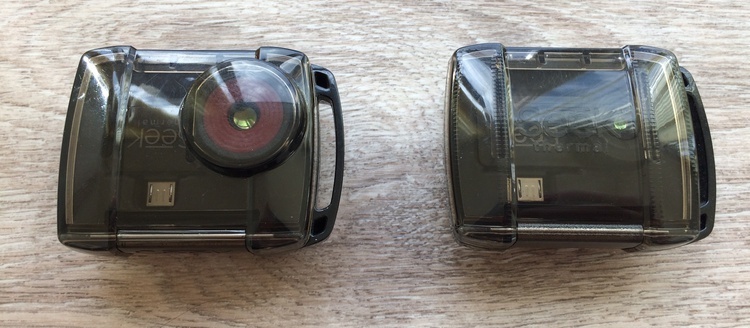
▌ Exterior
Outwardly, they are almost the same. The case is generally the same part. Is that the Pro lens is longer and has a red bezel. Weight, workmanship, materials - the same.

▌Optics
The Pro version of the lens is noticeably larger in diameter than the simple one.

5mm vs 3mm. That, in theory, should give a big luminosity. The focus adjustment wheel of the Pro version is spinning much easier and more enjoyable than the usual one. Although, perhaps, I just got a copy that was pretty much tortured by testers and was just developed. But nevertheless, it is much more convenient to twist the long, easily rotating lens. Especially when the imager itself is shallow and dangles on the smartphone.
The viewing angles of the imagers are as follows:
And there is some confusion, which I would like to resolve. The fact is that I have two versions on my hands: Compact (not XR!) And Compact Pro. They are determined by the software and the program writes that it is stuck in it. But my Compact'a focus is adjustable! Although everywhere I met it was written that the focus was fixed. Either there are two versions of the Compact, or once upon a time there was a version with a fixed lens, and now they put the focus everywhere. In general, there is some sort of misunderstanding.
▌Characteristics
Proshka is twice as expensive as usual. For what? For the characteristics. They are here twice as many in almost all directions. Judge for yourself:
The resolution of the usual (and XR) 32000 pixels, assembled in a matrix of 206x156 , 76800 and 76800 and the matrix of 320x240 in the protrusion. And this is not the resolution of the screen, it is not here, this is the resolution of the thermal imaging bolometric matrix itself. If we compare it with handheld thermal imagers, then in the same price range (up to 50 thousand) there are still a lot of devices in which the physical resolution of the bolometric matrix is 80x60, and 320x240 is only the resolution of the external display where the picture is drawn.
But, in justification of such devices, there the picture is made by combining the image from the camera and the thermal imager. In Seek Thermal, however, such a combination cannot be made and one has to be content with just a picture from a bolometer. And the resolution here is vital, because the higher it is, the more clearly you can imagine what is happening in the frame.
The second important point, which for some reason is not in the characteristics of this device in the catalog of the Djadget is the frame rate. The regular (and XR) version gives only 9 frames per second. I can not say that it is very small. No, that's enough in most cases. After all, we usually have to consider static things. Houses, pipes, some details. But after 15 frames per second, which the Pro version gives out, I don’t feel like returning to the regular one. Just a lot more comfortable working. The camera is less delayed, you find the object you need faster and more accurately, it is easier and more convenient to adjust the focus on fine details, less visual disorientation and quickly understand what exactly you see in the frame. Their temperature range is the same -40 ° to 330 ° C.
I also noticed that the Pro version of the "Zadran exposure." Where the usual gray background is less, without much noise, the brightness of the prosh is raised up, there are continuous noises, but you can see the details better. In this case, the exposure is floating. Those. He clicks his calibrating curtain, the brightness rises sharply, and then gradually fades away, then the click, again to the maximum and again decreases. It is approximately the same as a cheap soap box in auto mode trying to select an exposure. But not always, but only in difficult cases, when the frame has an approximately uniform thermal color. No sharp gradients.
▌Direct comparison
And now the slides. The type of apparatus is signed at the bottom of the frame
Let's start with the seals. Where do without them:
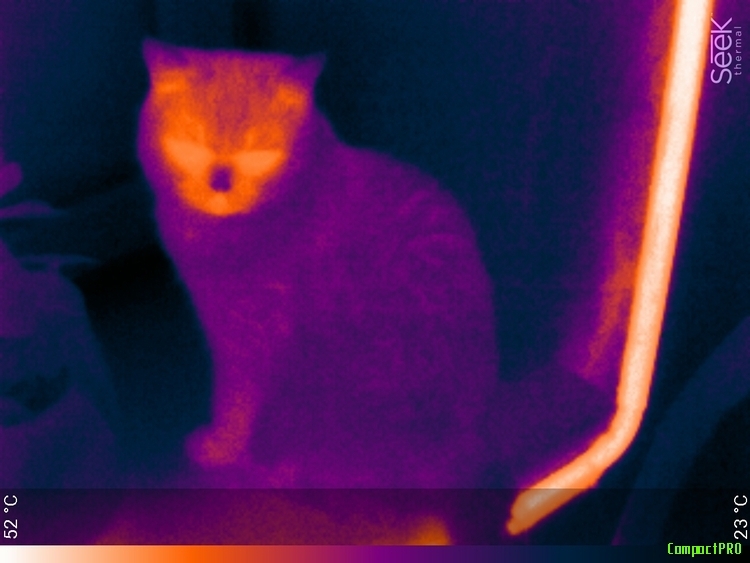
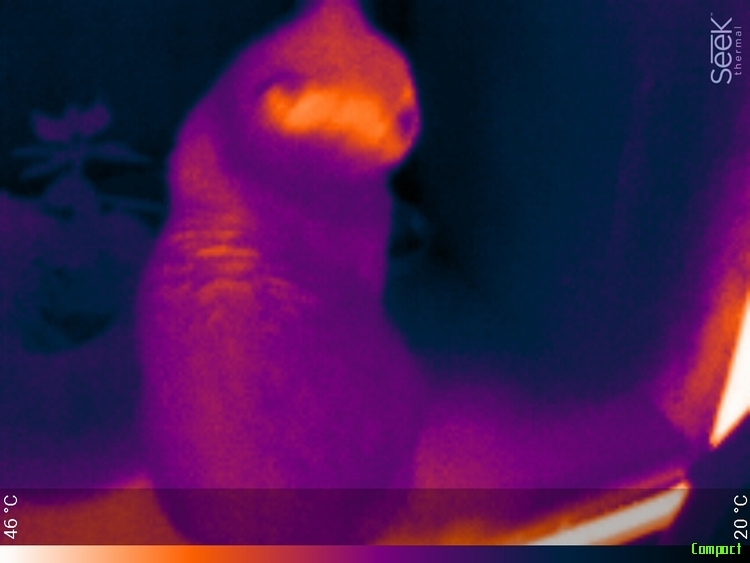
Redhead quality insulated.
Unlike bald.
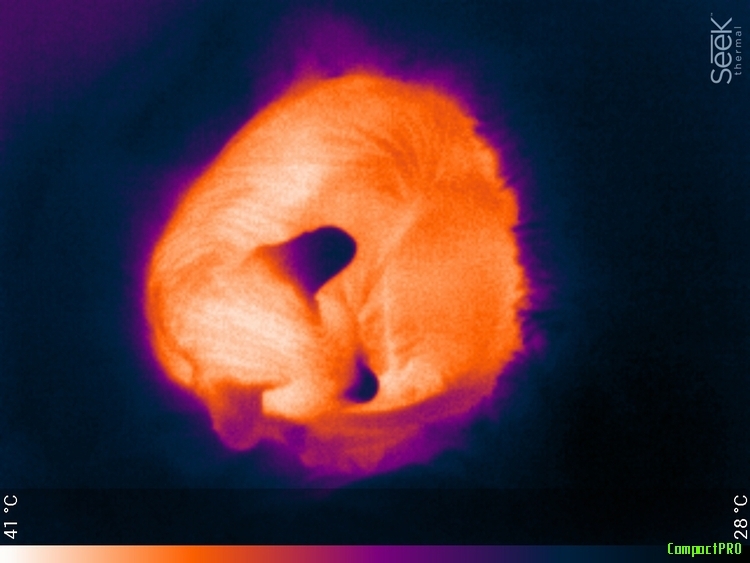
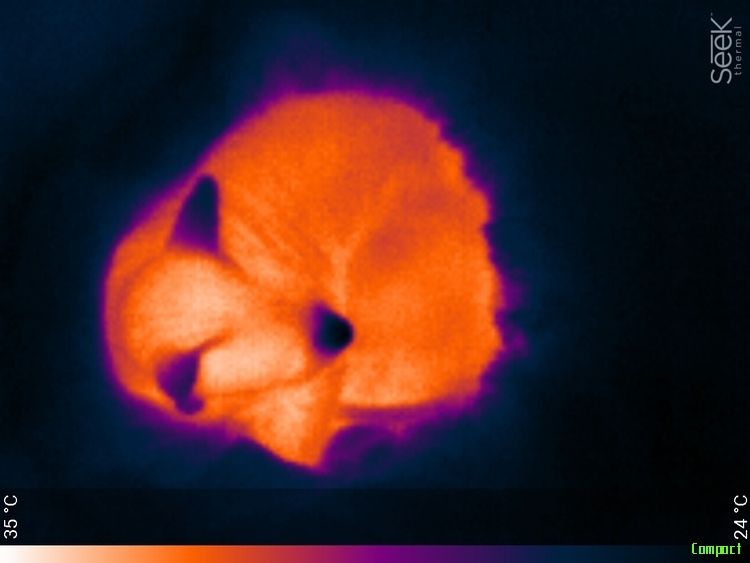
By the way, here PRO correctly determined the temperature. In cats, the rate of about 39-40 degrees. Bald is no exception.
We will look in the window of the adjacent factory.
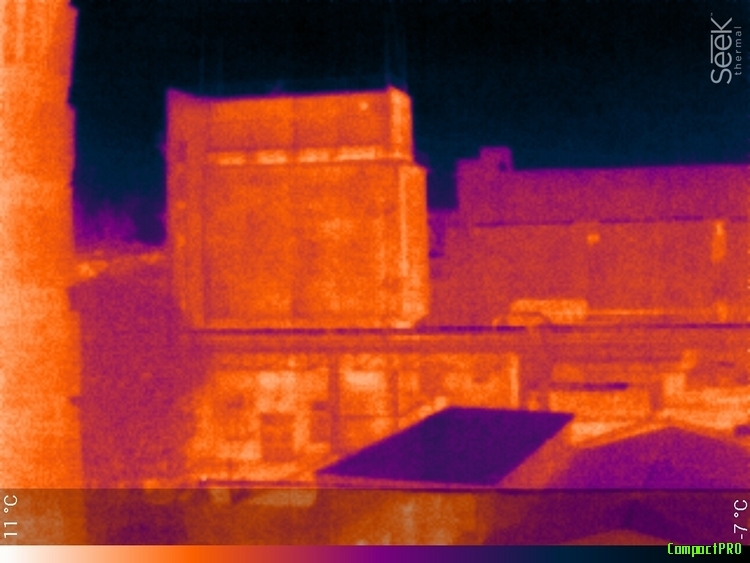
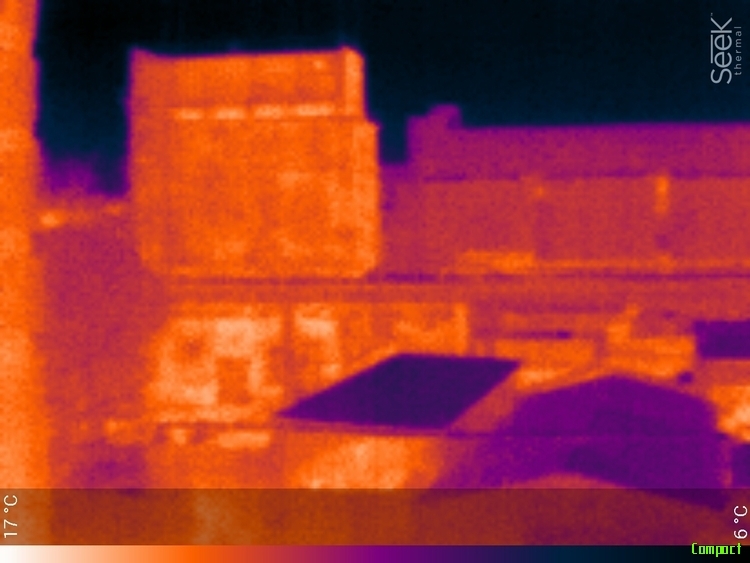
Greater resolution gives slightly clearer contours. But, in general, it does not matter.
People on the street in the Pro version are much better able to see the position of hands and legs. In general, for people, the difference between thermal imagers is striking.
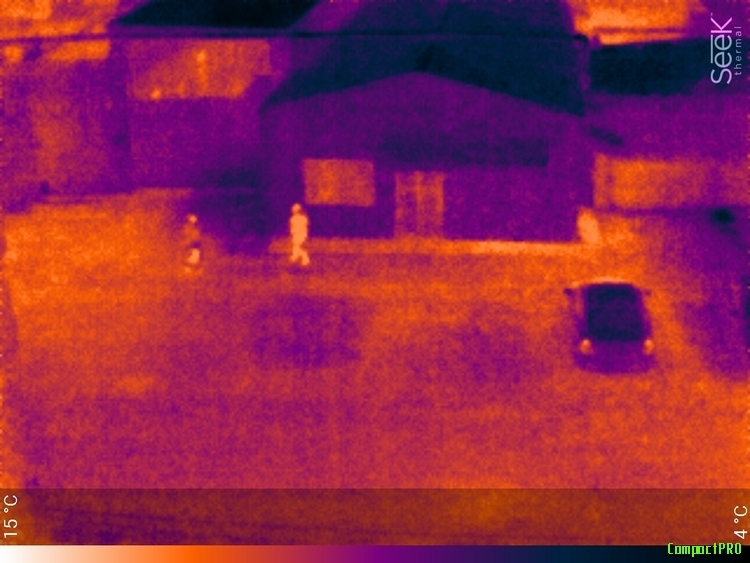
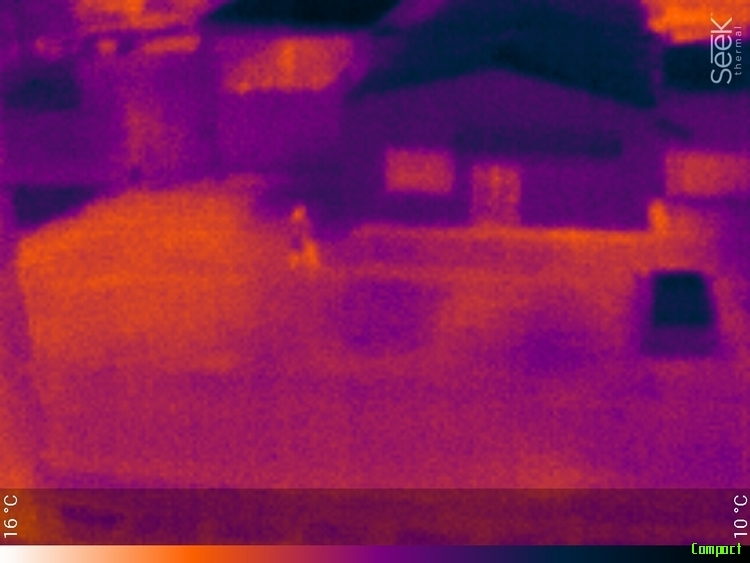
With circuit boards, everything becomes more interesting. For example, a working video card.
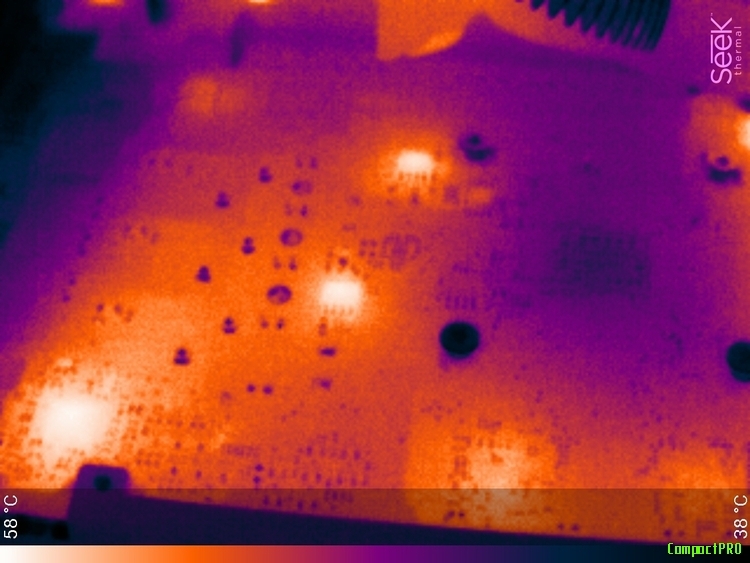

And here and there you can see the warming up power keys. Individual resistors are visible, but higher resolution gives clearer contours.
This is especially clearly seen if you can not crawl closer to the board.


Heat source behind bars. The difference is small and not fundamental.

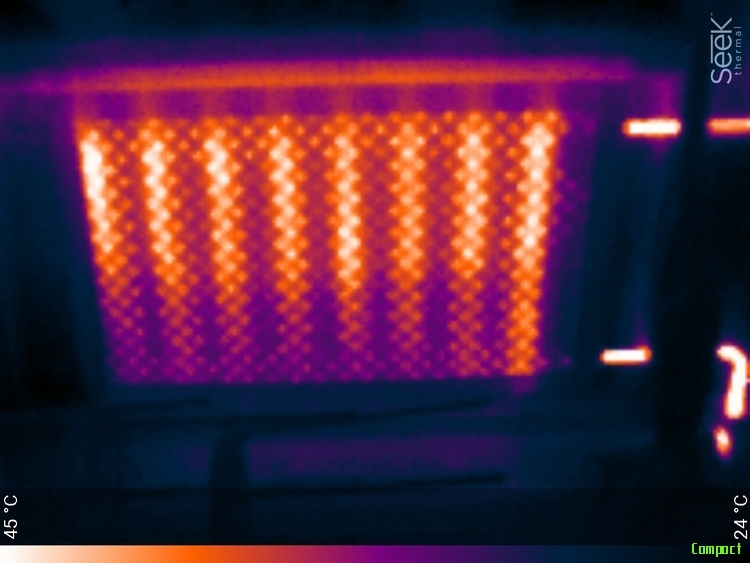
Device with a significant temperature difference. Printer extruder Heated to 205 degrees. Pro version adequately determines the temperature.

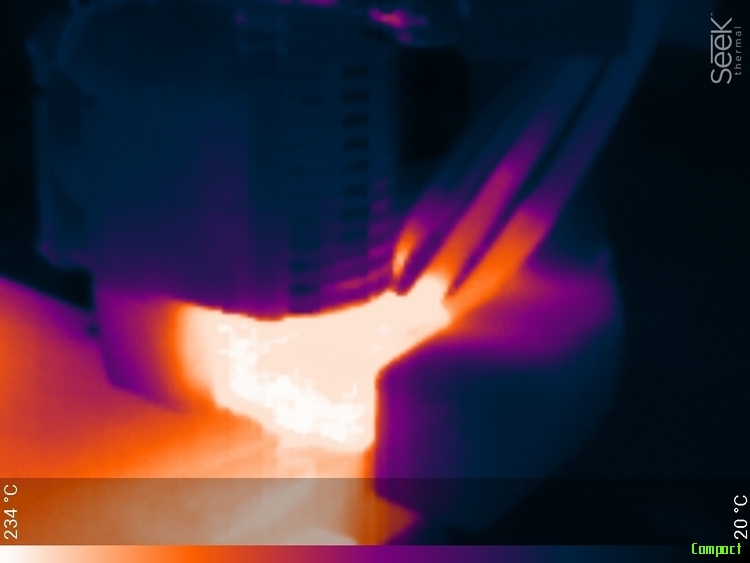
I also decided to try to compare the sensitivity of the instruments. To do this, I put a gas soldering iron, working on the smallest gas and issuing 300 degrees to the window sill. And he ran away to the far end of the corridor for 30 meters. It looked like this:
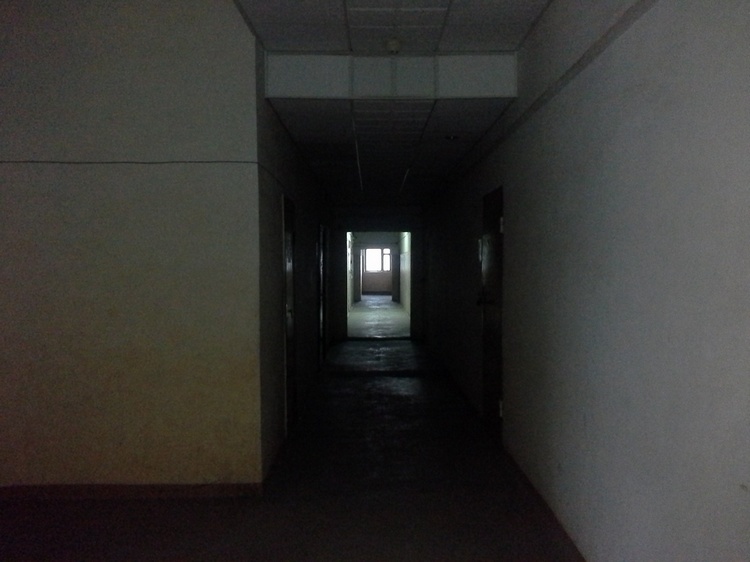
Both thermal imagers from 30 meters saw a hot spot to 300s. If you know that she is there and carefully look, then it was visible in both cases.
In the distance, one can clearly see only the window itself and the barely noticeable soldering iron candle. The pro version tries to draw out this darkness and turns up the brightness.
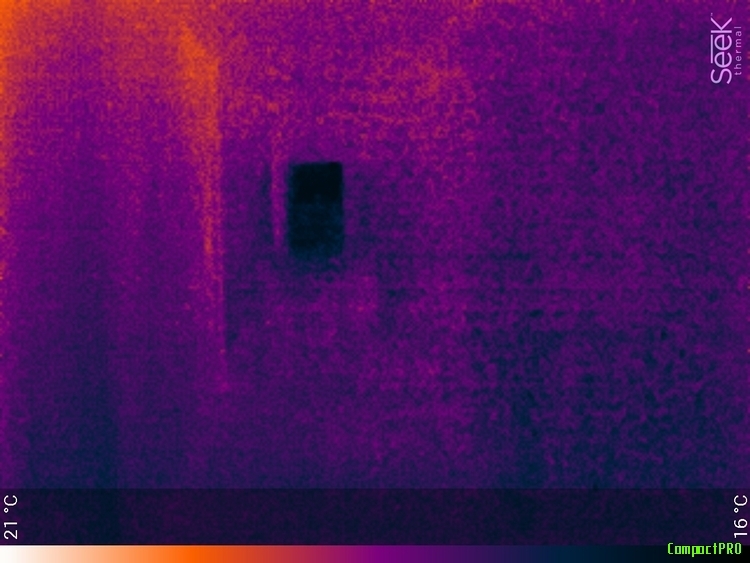

Here are the separately cut out fragments of the original resolution.
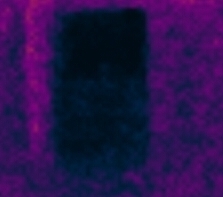
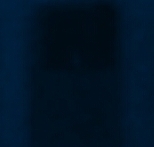
Match at 15 meters
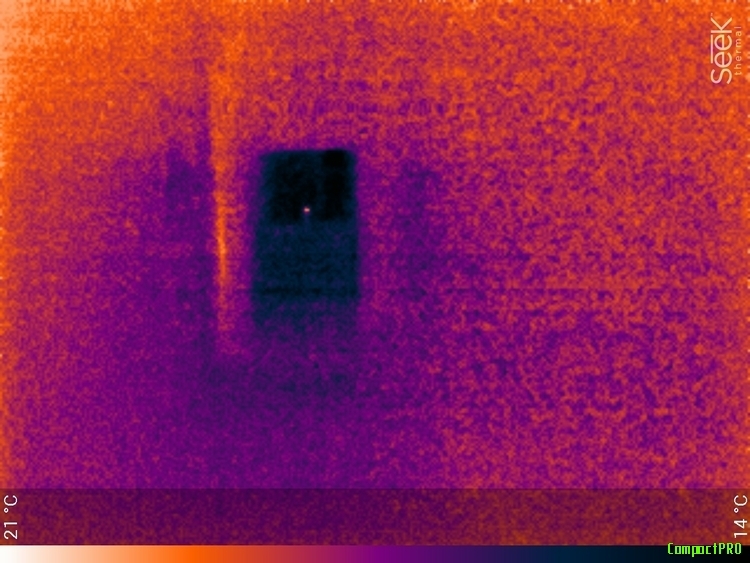
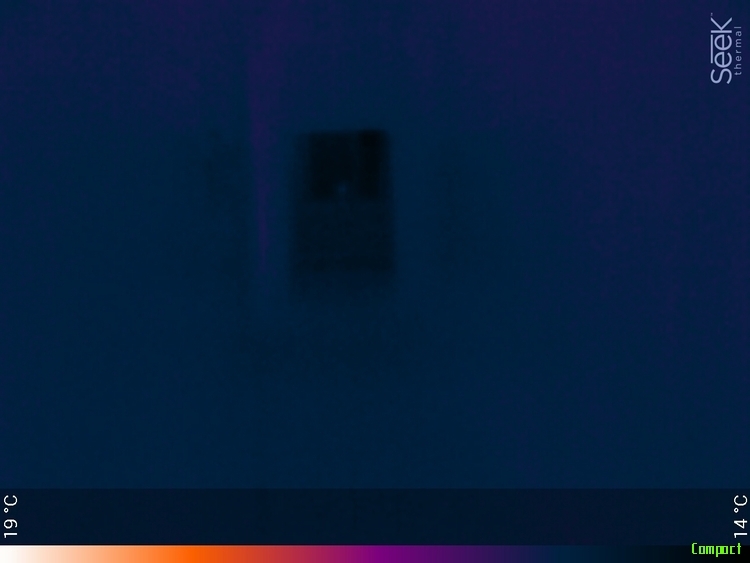
And 3 meters


Well, at close range, from one distance. The pro version, as usual, lifts the exposure.
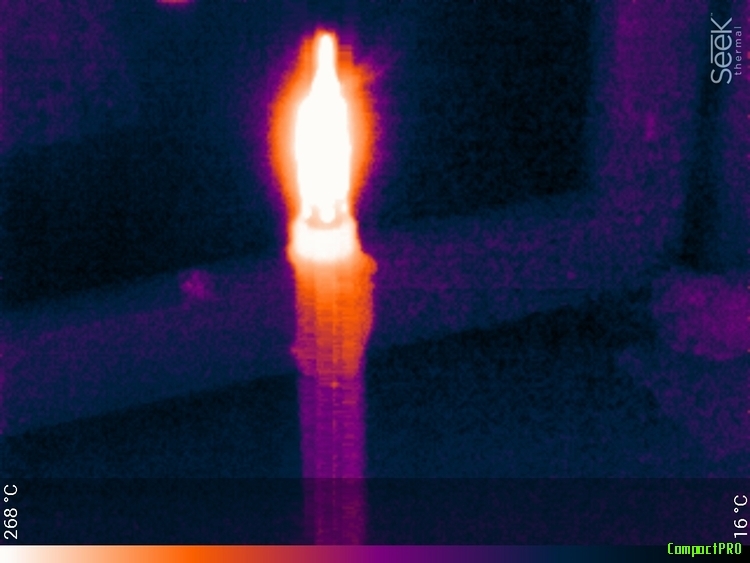

▌Soft
In addition to higher resolution in the Pro version, a new option is available in the software - forced range setting. Those. You can specify the boundaries of the color range at specific temperatures. All that is colder will be black, all that is warmer - white, well, and all the color or brightness gradients between them. It works, I must say, so-so. Since the compression range does not add measurement resolution. After all, all this is done programmatically. It looks like this:
Here is the original thermogram:

But I applied this option, compressing the range to the boundaries of 48 ... 19 degrees. A little bit of detail added to the pipe itself. Apparently this is the roughness of the paint or some dirt.
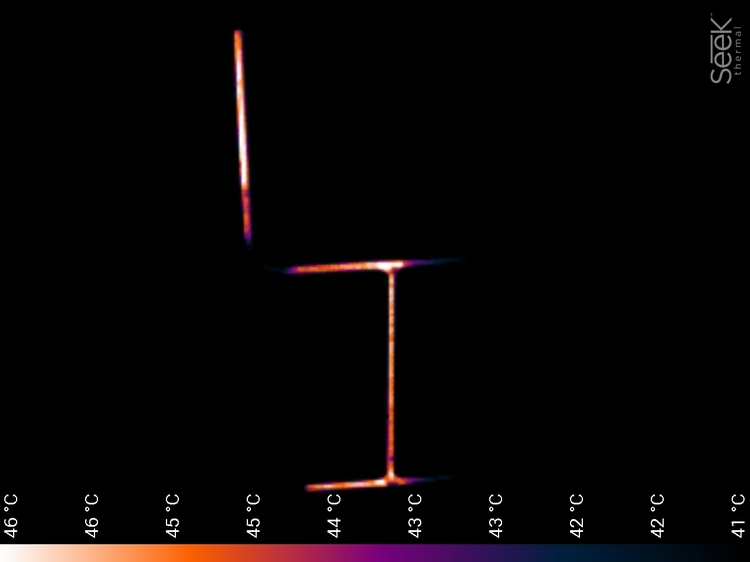
Environment disappeared. Highlighting the hottest object. And the range of displayed temperatures from the floating became fixed. Moreover, the range can be changed not arbitrarily, but only from those temperatures that the imager determined at the time before switching on this mode. And in order to change the range, you must exit this mode and enter it again. In general, crookedly done. No matter how hard I tried, I did not find practical use of this mode. Since sharp gradients visible and so. And small differences they can not get out anyway, the accuracy of the matrix is not enough.
▌Dependence of temperature on the surface color
The thermal imager does not measure the temperature, it sees the radiated heat and only on the basis of this does it draw indirect conclusions about the temperature of the body. And the amount of radiated heat strongly depends on the surface. The black matte surface has more radiation (and absorption) and the temperature of the black body, determined by the thermal imager, will be closest to the truth.
Metal and glass perfectly reflects the infrared radiation and looking at some glitter on the table, it may seem that it is very hot, but in fact it just reflects the heat from the desk lamp. I decided to conduct a small experiment on this topic. I took the blackened aluminum radiator in different ways, and then filmed it in a heated state.
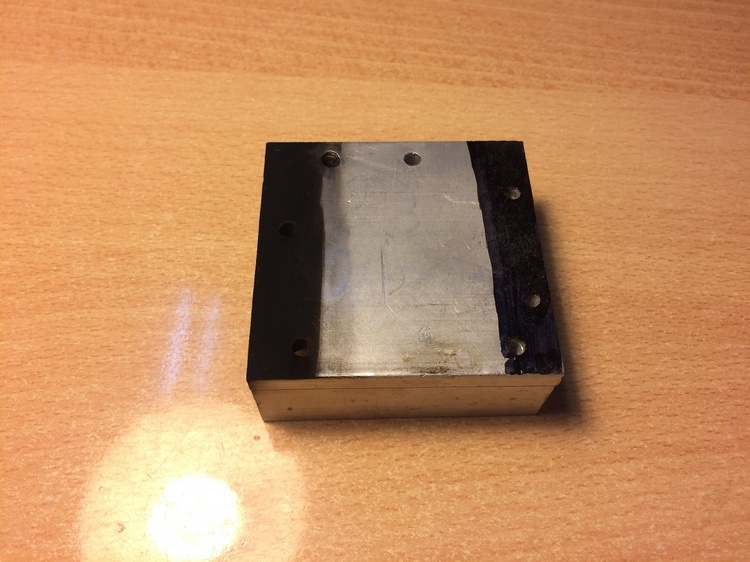
The first way of blackening is the usual permanent marker. Took and painted over the surface. From the other end I covered the surface with soot. Normal soot - set fire to wood and smoked. The center remained as it is, gray smooth aluminum. Not polished in the mirror. Heated. Measured with a contact thermometer - about 40 degrees on the upper surface. We look!

Soot gave the most accurate temperature transfer. Degree to degree. The marker worked a little worse, and everything is clearly visible on the metal surface. Mirror surfaces, glass, polished metal - look like very cold, but it is not so of course.
▌Conclusion
What device to choose ... a difficult question. In principle, they both do an excellent job with their tasks. Normal cheaper . But with the Pro version it is a little more pleasant to work, a clearer picture and faster response.
And traditionally for those who want to buy with a 10% discount, there is a promotional code GT-ST.
▌ Packing
It is surprisingly different. And I liked the box from the regular version more. Although the strength and rigidity of both are beyond doubt. For shipment you can not be afraid. Armor, not box. True, it would be better for manufacturers not to show off and put it still in the case before the heap, and not lay it out on the lodgements.

')
The case is the same, but there is a small protrusion under the larger lens of the Pro version. And so the same thing - good-quality waterproof box with reliable hinges and locks.

▌ Exterior
Outwardly, they are almost the same. The case is generally the same part. Is that the Pro lens is longer and has a red bezel. Weight, workmanship, materials - the same.

▌Optics
The Pro version of the lens is noticeably larger in diameter than the simple one.

5mm vs 3mm. That, in theory, should give a big luminosity. The focus adjustment wheel of the Pro version is spinning much easier and more enjoyable than the usual one. Although, perhaps, I just got a copy that was pretty much tortured by testers and was just developed. But nevertheless, it is much more convenient to twist the long, easily rotating lens. Especially when the imager itself is shallow and dangles on the smartphone.
The viewing angles of the imagers are as follows:
- Compact 36 ° focusing fixed?
- CompactXR 20 ° focus adjustable
- Compact Pro 32 ° focus adjustable
And there is some confusion, which I would like to resolve. The fact is that I have two versions on my hands: Compact (not XR!) And Compact Pro. They are determined by the software and the program writes that it is stuck in it. But my Compact'a focus is adjustable! Although everywhere I met it was written that the focus was fixed. Either there are two versions of the Compact, or once upon a time there was a version with a fixed lens, and now they put the focus everywhere. In general, there is some sort of misunderstanding.
▌Characteristics
Proshka is twice as expensive as usual. For what? For the characteristics. They are here twice as many in almost all directions. Judge for yourself:
The resolution of the usual (and XR) 32000 pixels, assembled in a matrix of 206x156 , 76800 and 76800 and the matrix of 320x240 in the protrusion. And this is not the resolution of the screen, it is not here, this is the resolution of the thermal imaging bolometric matrix itself. If we compare it with handheld thermal imagers, then in the same price range (up to 50 thousand) there are still a lot of devices in which the physical resolution of the bolometric matrix is 80x60, and 320x240 is only the resolution of the external display where the picture is drawn.
But, in justification of such devices, there the picture is made by combining the image from the camera and the thermal imager. In Seek Thermal, however, such a combination cannot be made and one has to be content with just a picture from a bolometer. And the resolution here is vital, because the higher it is, the more clearly you can imagine what is happening in the frame.
The second important point, which for some reason is not in the characteristics of this device in the catalog of the Djadget is the frame rate. The regular (and XR) version gives only 9 frames per second. I can not say that it is very small. No, that's enough in most cases. After all, we usually have to consider static things. Houses, pipes, some details. But after 15 frames per second, which the Pro version gives out, I don’t feel like returning to the regular one. Just a lot more comfortable working. The camera is less delayed, you find the object you need faster and more accurately, it is easier and more convenient to adjust the focus on fine details, less visual disorientation and quickly understand what exactly you see in the frame. Their temperature range is the same -40 ° to 330 ° C.
I also noticed that the Pro version of the "Zadran exposure." Where the usual gray background is less, without much noise, the brightness of the prosh is raised up, there are continuous noises, but you can see the details better. In this case, the exposure is floating. Those. He clicks his calibrating curtain, the brightness rises sharply, and then gradually fades away, then the click, again to the maximum and again decreases. It is approximately the same as a cheap soap box in auto mode trying to select an exposure. But not always, but only in difficult cases, when the frame has an approximately uniform thermal color. No sharp gradients.
▌Direct comparison
And now the slides. The type of apparatus is signed at the bottom of the frame
Let's start with the seals. Where do without them:


Redhead quality insulated.
Unlike bald.


By the way, here PRO correctly determined the temperature. In cats, the rate of about 39-40 degrees. Bald is no exception.
We will look in the window of the adjacent factory.


Greater resolution gives slightly clearer contours. But, in general, it does not matter.
People on the street in the Pro version are much better able to see the position of hands and legs. In general, for people, the difference between thermal imagers is striking.


With circuit boards, everything becomes more interesting. For example, a working video card.


And here and there you can see the warming up power keys. Individual resistors are visible, but higher resolution gives clearer contours.
This is especially clearly seen if you can not crawl closer to the board.


Heat source behind bars. The difference is small and not fundamental.


Device with a significant temperature difference. Printer extruder Heated to 205 degrees. Pro version adequately determines the temperature.


I also decided to try to compare the sensitivity of the instruments. To do this, I put a gas soldering iron, working on the smallest gas and issuing 300 degrees to the window sill. And he ran away to the far end of the corridor for 30 meters. It looked like this:

Both thermal imagers from 30 meters saw a hot spot to 300s. If you know that she is there and carefully look, then it was visible in both cases.
In the distance, one can clearly see only the window itself and the barely noticeable soldering iron candle. The pro version tries to draw out this darkness and turns up the brightness.


Here are the separately cut out fragments of the original resolution.


Match at 15 meters


And 3 meters


Well, at close range, from one distance. The pro version, as usual, lifts the exposure.


▌Soft
In addition to higher resolution in the Pro version, a new option is available in the software - forced range setting. Those. You can specify the boundaries of the color range at specific temperatures. All that is colder will be black, all that is warmer - white, well, and all the color or brightness gradients between them. It works, I must say, so-so. Since the compression range does not add measurement resolution. After all, all this is done programmatically. It looks like this:
Here is the original thermogram:

But I applied this option, compressing the range to the boundaries of 48 ... 19 degrees. A little bit of detail added to the pipe itself. Apparently this is the roughness of the paint or some dirt.

Environment disappeared. Highlighting the hottest object. And the range of displayed temperatures from the floating became fixed. Moreover, the range can be changed not arbitrarily, but only from those temperatures that the imager determined at the time before switching on this mode. And in order to change the range, you must exit this mode and enter it again. In general, crookedly done. No matter how hard I tried, I did not find practical use of this mode. Since sharp gradients visible and so. And small differences they can not get out anyway, the accuracy of the matrix is not enough.
▌Dependence of temperature on the surface color
The thermal imager does not measure the temperature, it sees the radiated heat and only on the basis of this does it draw indirect conclusions about the temperature of the body. And the amount of radiated heat strongly depends on the surface. The black matte surface has more radiation (and absorption) and the temperature of the black body, determined by the thermal imager, will be closest to the truth.
Metal and glass perfectly reflects the infrared radiation and looking at some glitter on the table, it may seem that it is very hot, but in fact it just reflects the heat from the desk lamp. I decided to conduct a small experiment on this topic. I took the blackened aluminum radiator in different ways, and then filmed it in a heated state.
The first way of blackening is the usual permanent marker. Took and painted over the surface. From the other end I covered the surface with soot. Normal soot - set fire to wood and smoked. The center remained as it is, gray smooth aluminum. Not polished in the mirror. Heated. Measured with a contact thermometer - about 40 degrees on the upper surface. We look!

Soot gave the most accurate temperature transfer. Degree to degree. The marker worked a little worse, and everything is clearly visible on the metal surface. Mirror surfaces, glass, polished metal - look like very cold, but it is not so of course.
▌Conclusion
What device to choose ... a difficult question. In principle, they both do an excellent job with their tasks. Normal cheaper . But with the Pro version it is a little more pleasant to work, a clearer picture and faster response.
And traditionally for those who want to buy with a 10% discount, there is a promotional code GT-ST.
Source: https://habr.com/ru/post/373403/
All Articles